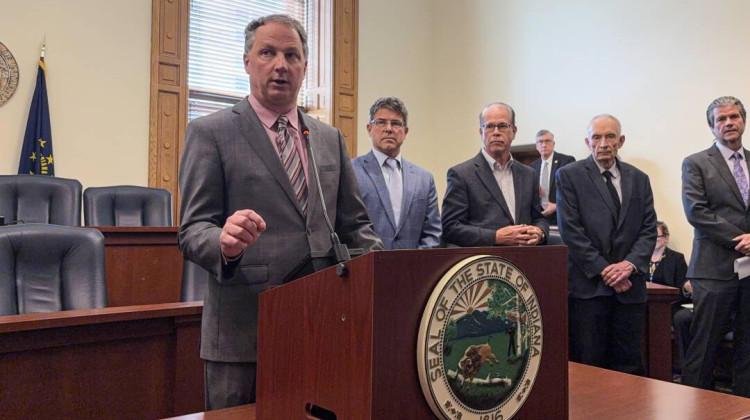
Josu 'Z' Barros and spouse Carrie Barros of Evansville, stock the fridge after a shopping trip. A family of six with four teens/preteens, they can't afford to waste food. Carrie said she often under-shops for groceries to avoid waste. Experts think many families have poor inventory management skills, which leads to food waste.
Tim Jagielo / WNIN News
In Evansville, Indiana, Wesselman’s Grocery Outlet Assistant Manager Ralph Yellig is stocking cheese and garlic croutons in the discount aisle, the packages crinkling together into a large cardboard display box.
They’re only $.65 and the catch is — they’re two weeks past their “best by” date.
The entire aisle is close-dated or past the date on the packaging. There’s even meat and cooler items. Manager Mark Jebker said this is the first stop for many of his shoppers.
“We can fill this entire side up and it won't last two to three days,” he said. “It'll be almost completely empty. Bargains are bargains; people are looking for, you know, that value.”
There’s post-dated Hellman’s mayo for $2.25, canned sliced pears for $.45, two pounds of brown sugar for $.85, sweet relish pickles a few weeks over date — $.45. The discount is of course based on all these food date labels.
“And there is really no complete guideline as to what to look for whether it be ‘used by’ ‘best by.’ It kind of depends on the item that you're buying,” Jebker said. “I mean, milk I mean, I've had milk in my refrigerator 14 days past its ‘best-by’ date.”
He said some items are even “coded” with no obvious date information. “And the only way you know how good it is, is if you know what those codes are,” he said.
Brenna Ellison is an associate professor in agricultural economics at Purdue University. An area of interest for her are these various date labels on food.
“We have ‘sell by,’ we've had like, ‘best If used by’ ‘best by,’ there's kind of been all sorts of variants,” she said. “And so I think that's where the confusion comes in.”
And that confusion can lead to food waste. People toss a post-date food item when really the label was there to convey quality, not safety, she said, adding that the only expiration dates that are regulated are for baby formula. “So anything else is actually not regulated by the government and a lot of it is a product of the manufacturer or the retailer putting the dates on the product.”
According to the USDA, between 30 to 40-percent of food produced in the U.S. is wasted or lost, equaling about $160 billion U-S dollars.
The USDA specifically looks at retail and household food waste, according to Ellison. “And so if you look at that 31-percent (waste) and want to break it down two thirds of that, which is about 20-percent, they give that that's credited to households, whereas the other 10-percent would be to grocery retailers.”
And you’ve read this correctly — it’s not the grocery stores or the restaurants with the most waste — it’s regular households.

On a Wednesday Evening, spouses Josué (who goes by ‘Z’) and Carrie Barros of Evansville are putting groceries away after a quick Aldi run.
They have four children. One is a preteen — the rest are teens.
“So it's very expensive to feed a family of six, and especially with a teenage son who's bulking all the time,” Carrie said. “ We go through a lot of food.”
When shopping, Carrie intentionally seeks out deals often based on a "best by" date. If it’s perishable, she cooks it immediately or throws it into the freezer.
“So for me — like a ‘sell by’ date doesn't mean that once that date is passed, it's not good anymore,” she said. “It just means that the store can't sell it past that date. So for us, it's probably still good. And I just tried to use it more quickly.”
Z said he definitely sees it more as a guideline, “not a hard-and-fast rule.”
Z and Carrie grew up with different food cultures — and hemispheres. Carrie grew up in the United States; Z grew up in Brazil. (Their surname is pronounced “Ba-hos.”)
The first time he heard his future in-laws say “when in doubt, throw it out,” he thought it was a joke.
“And then I proceeded to see them take the food because they were ‘in doubt,’ and throw it in the garbage,” recalled Z. “And I said, ‘Oh, they really think that, they really live that way.’ You know, our motto was ‘what doesn't kill you makes you stronger.’ So you just keep keep trying and you smell the milk and you have a sip of it and make sure it's not all the way sour.”
“When I see when we find something in the back of the fridge that went bad or was moldy, and we have to throw it out, oh it breaks my heart.”
Carrie had almost the opposite experience spending time in Brazil when they were engaged.
“I soon figured out that if there was a towel over a pot of beans or rice or whatever it was, or if it was thrown in the microwave with the door shut, then it was going to 'keep it from spoiling.'”
She said growing up, her mother was less conservative and willing to try post-date foods — not her father.
But today they fight food waste in their own ways. Carrie has learned to actually shop for two fewer meals than she thinks they’re going to need.
“I feel like a lot of people buy way more than they're going to actually consume in the amount of time that it's good for, or it's in the back of the fridge or they don't do a good job of communicating between family members, like what needs to be eaten first, what what's going to spoil first."
Ellison echoes this. “Quite often … people are bad inventory managers of food,” she said. “So we often over buy, because we would rather not run out those sorts of things.”

This includes the Food Marketing Institute and the Grocery Manufacturers Association trying to get producers on a two-label scheme — a ‘“best by” and “use by” label. The “best by” refers to freshness, and “use by” refers to safety. It’s been gaining traction in the past few years.
Alejandra said her project did alter her view of food waste. She’s a little more aware of how much food is wasted around her — even though not everyone in the class understood the law she shared.
Alejandra’s teacher Eric Hormuth hadn’t really considered food-date labels prior to this.
“I learned that maybe my food lasts a little bit longer than I think it does,” he said. “And just because my yogurt says it's ‘best by,’ you know, two weeks from when I bought it, it might actually last longer than that.”
He’s observed the food waste in his own home — like tossing an entire item instead of cutting off the mold — “Because I just find mold very gross,” he said.
But mold aside — he no longer automatically tosses past-date food.
And while the USDA doesn't currently regulate food labels, there are are initiatives by the USDA and the EPA to curb food waste in the U.S — such as the 2030 Food Loss and Waste 2023 Champions program.
Through this, corporations like Aldi and Starbucks have agreed to reduce food loss and waste in their operations by half, by 2030. As of May 2022, 45 corporations have joined like Sysco, Aramark and Amazon.
Ellison said the US is used to an abundance of food, and it might take consumers demanding a change in the label system.

9(MDAyMzk1MzA4MDE2MjY3OTY1MjM5ZDJjYQ000))
 DONATE
DONATE






 Support WFYI. We can't do it without you.
Support WFYI. We can't do it without you.